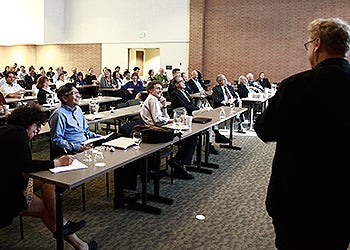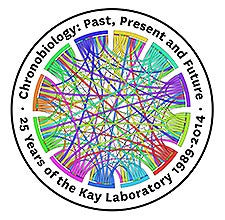Biological Time Flies
USC Dornsife Dean Steve Kay often describes his ambitious goals for cross-disciplinary collaboration.
However, what some may not know is that as a scientist Kay not only espouses these ideas, but has been among the first to advance them.
“Steve has always emphasized that one expert alone cannot solve a big problem,” said Satchin Panda, associate professor of regulatory biology at the Salk Institute for Biological Studies in La Jolla, California. “You must have access to people with various expertise. You must be able to network with the right people who can help you tackle the problem.”
Panda, who was among Kay’s first doctoral students when his laboratory was located at The Scripps Research Institute in La Jolla, co-organized, “Chronobiology: Past, Present and Future,” a 25-year anniversary symposium of the Kay laboratory. Held May 30 in the Davidson Continuing Education Conference Center at USC, the event drew more than 100 of Kay’s former and current students and colleagues. Some traveled from as far as Scotland, Japan, Spain, Argentina and China to be there.
About 15 years ago, Kay mentioned to Panda that he envisioned a gathering in which speakers from his lab would present their research.
Then in 2013, Panda attended a conference in Argentina and realized that nearly all of the speakers had started their careers in Kay’s laboratory.
“I thought, ‘We should celebrate this,’ ” said Panda, who worked with the Kay laboratory’s long-time manager Toni Lestelle to bring the event to fruition.
“So many of Steve’s former students have gone on to have great careers — doing such good science,” Panda said. “He is different because he produces both papers and people. This symposium is a testament to his science and his legacy.”

More than 100 of Kay’s former and current students and colleagues attended the symposium held May 30 in the Davidson Continuing Education Conference Center at USC. Photo by Eric Larsen Images.
Kay, who holds the Anna H. Bing Dean’s Chair in addition to faculty appointments in molecular and computational biology at USC Dornsife as well as in neurology, physiology and biophysics at the Keck School of Medicine of USC, focuses his research on circadian rhythms, or the innate biological clock. His research models are plants — although other researchers in his laboratory study circadian rhythms in species that range from flies to mice and ultimately humans.
Arriving at USC Dornsife in 2012, Kay is a member of the National Academy of Sciences and an internationally recognized expert on genes and circadian rhythms. He has published more than 200 papers and was named by the Institute for Scientific Information as a highly cited scientist.
Among Kay’s many accolades and honors, Science magazine has placed his groundbreaking work on its “Top-Ten Breakthroughs of the Year” list three times.
Some of Kay’s research has shown that people are best able to handle difficult conversations or tackle math problems at 9 a.m., that our peak workout hour is 5 p.m. and that we are most creative at 9 p.m. — because we’re a little sleepy and therefore less inhibited. He also cites that, according to our biological clocks, 2 p.m. is the best time for a nap.
Kay and his team also uncovered circadian rhythms in the liver governed by a protein called cryptochrome. Cryptochrome controls hepatic-gloconeogenesis —or how much glucose the liver makes when a person is fasting. According to his research, when these biological clocks in the liver go wrong, animals may develop diabetes. By understanding these biochemical processes, Kay believes we are on the way to making headway in developing better treatments for diabetes.
“Steve was definitely on the forefront of being amenable to both working with Industry and sending postdocs off to careers in addition to academia,” said Shawn Anderson, Kay’s first postdoctoral researcher at the University of Virginia in 1992. She has worked for DuPont since leaving Kay’s lab and now works as a research planning manager for DuPont Industrial Biosciences.
“Very early on, Steve connected us with people at the UVA medical school,” Anderson continued. “Something I’ve carried with me from my days with Steve is that you need to get together with people outside of your immediate area so that you can be informed and come up with new ideas based on the intellectual friction that takes place as a result of those broadening contacts.”

“Chronobiology: Past, Present and Future,” the 25-Year anniversary symposium of the Kay Laboratory was held at USC on May 30.
John Hogenesch, professor of pharmacology at the University of Pennsylvania, presented his research titled, “A Network of Clocks: Health, Drug Action and Dark Matter.” Hogenesch has continued working in the field of circadian rhythms, working predominantly with mice and humans as models.
“Kay was the best motivator I’ve ever worked with — maybe ever seen,” Hogenesch said. “His lab established a culture of excellence. People were competitive but not with each other — we tried to help each other. We were a group of strongly ambitious, creative, well-resourced people working together, and that’s very unusual.”
Through his presentation “Chronobiology: Past, Present and Future,” Kayillustrated what everyone had already said about him — scientists can be gregarious, engaging and quite funny. Part roast of his former students and part tour of his research spanning the last quarter century, the presentation wove together complex diagrams of chemical interactions and photographs of former students — some shaggy-haired but now clean-shaven.
“I’ve always enjoying finding people who can be aggressive in the lab but also collegial,” Kay said.
Describing his own philosophy for success, Kay said, “You need to be willing to take risks. No dotting the i’s and crossing the t’s. You need to swing the bat as hard as you can and not worry about the odd times that it flies out of your hand.”
Andrew Millar, professor of systems biology for SynthSys, the synthetic and systems biology department at the University of Edinburgh, traveled from Scotland for the symposium.
“I couldn’t possibly have missed this,” said Millar, who worked with Kay at Rockefeller University from 1989-1991. “I worked in the same office as Steve for four years, and he taught me almost all of the molecular biology methods I know. He was much more than a supervisor; he was my big brother in science.”